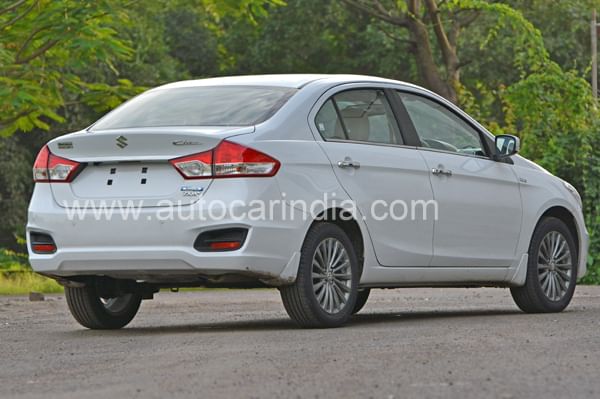2015 Maruti Ciaz SHVS diesel hybrid review, test drive
The Maruti Ciaz becomes even more frugal, thanks to the clever fuel-saving tech with a mild-hybrid system. Here are our first impressions.
Published on Aug 25, 2015 12:01:00 AM
3,32,059 Views
Follow us on



What is it?
It's been almost a year since Maruti launched its genuine Honda City rival, the Maruti Ciaz, in our market. Right from the word go, the Ciaz had it all in order – the looks, competent engines, generous rear legroom and a long list of features – to beat the segment leader. The Ciaz has even managed to dethrone the City’s closest rival, the Verna, and take the second spot in overall sales segment since its launch, but has struggled a bit to find more buyers than the City.
Also, in terms of fuel efficiency, the City diesel has an ARAI-claimed 26kpl while the Ciaz diesel closes in with a 26.21kpl figure. In a quest to up the kpl game and to improve sales numbers, Maruti will soon bring a mild-hybrid version of the Ciaz diesel to our market. Dubbed the Ciaz SHVS, this Ciaz diesel gets a package of fuel-saving tech which helps it deliver an ARAI-claimed figure of 28.09 kpl. That's 1.88kpl more than the non-SHVS Ciaz and 2.09kpl more than the City diesel. We got behind the wheel of the new Ciaz SHVS for a quick spin to find out where the differences lie.
| Maruti Suzuki Ciaz Price, Mileage, Specifications, Features and Variants | |
|---|---|
| Brand | Maruti Suzuki |
| Model Name | Ciaz |
| Maruti Suzuki Ciaz Price | ₹ 10.63 - 14.35 lakh |
| Maruti Suzuki Ciaz Range/Mileage | Petrol Hybrid : 20.28 - 21.56kpl |
| Maruti Suzuki Ciaz Specifications | Sedan | 4 doors | 5 seats View All Specs |
| Maruti Suzuki Ciaz Features | LED headlight | 7-inch Touchscreen display | 2 airbags View All Features |
| Maruti Suzuki Ciaz Variants | 1.5 Petrol Sigma MT | 1.5 Petrol Delta MT | 1.5 Petrol Zeta MT View All Variants |

On the exterior, the Ciaz SHVS looks exactly like the standard car, save for the new 'SHVS' badging on the boot. The variant nomenclature for the Ciaz SHVS also carries forward with similar equipment as the non-hybrid car. The interiors too are similar to its predecessor; the simple, uncluttered dashboard, and the easy to read dials are still in there. Speaking of the dials, the Ciaz SHVS does get additional indicators. More on that later.
What is it like to drive?
As part of the 'Smart Hybrid Vehicle by Suzuki' (SHVS) upgrade, the Ciaz gets what Maruti calls an ISG (Integrated Starter Generator). The Ciaz SHVS comes with a segment-first dedicated start-stop system which can be brought into action with the press of a button located to the right of the steering wheel, beside the switch for the parking sensors and fog lamps. This system is similar to the one seen on the Micro-Hybrid Mahindra vehicles and quite a few high-end cars in our market. It comes in to play by shutting down the engine when the car comes to a complete halt and deactivates itself when the driver presses the clutch and allows the engine to restart. We found this system being activated approximately within four to five seconds of the vehicle being brought to a complete stop. There’s a dedicated sign on the instrument panel that glows when this system is active. As per the company claim, the system is said to deactivate itself if the driver unfastens his seat belt or if the driver’s door is opened.
Copyright (c) Autocar India. All rights reserved.



.jpg?w=234&h=156&q=90&c=1)


Comments
Member Login
Personal Details
No comments yet. Be the first to comment.